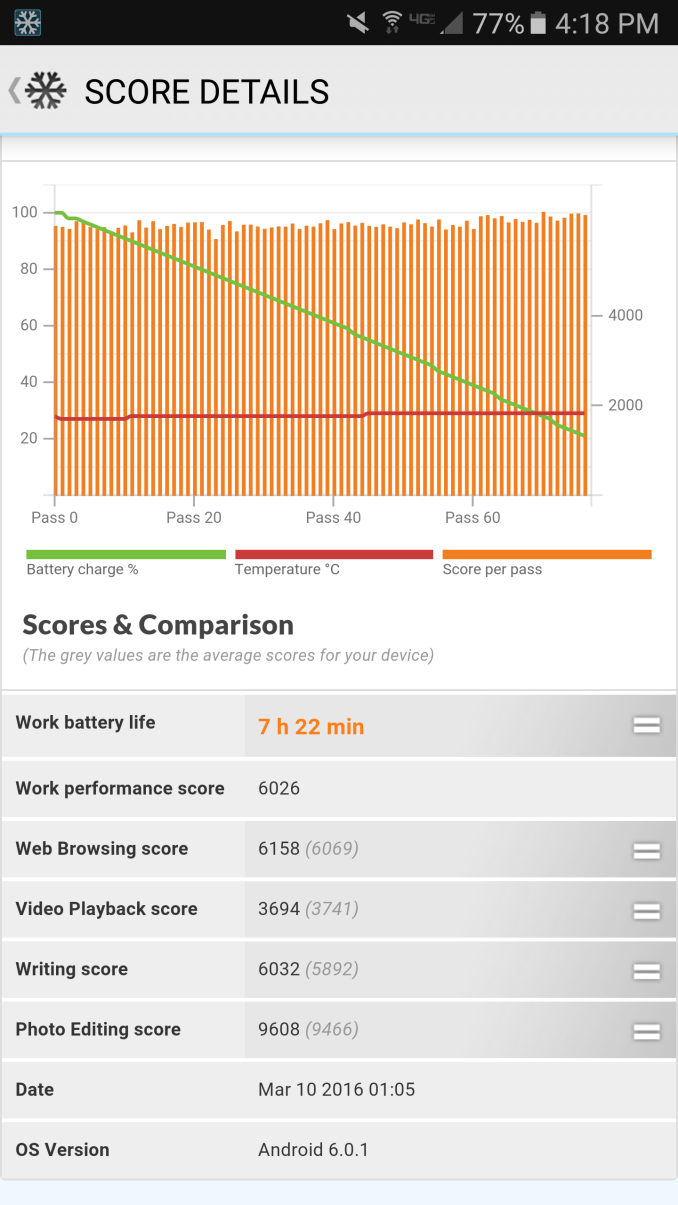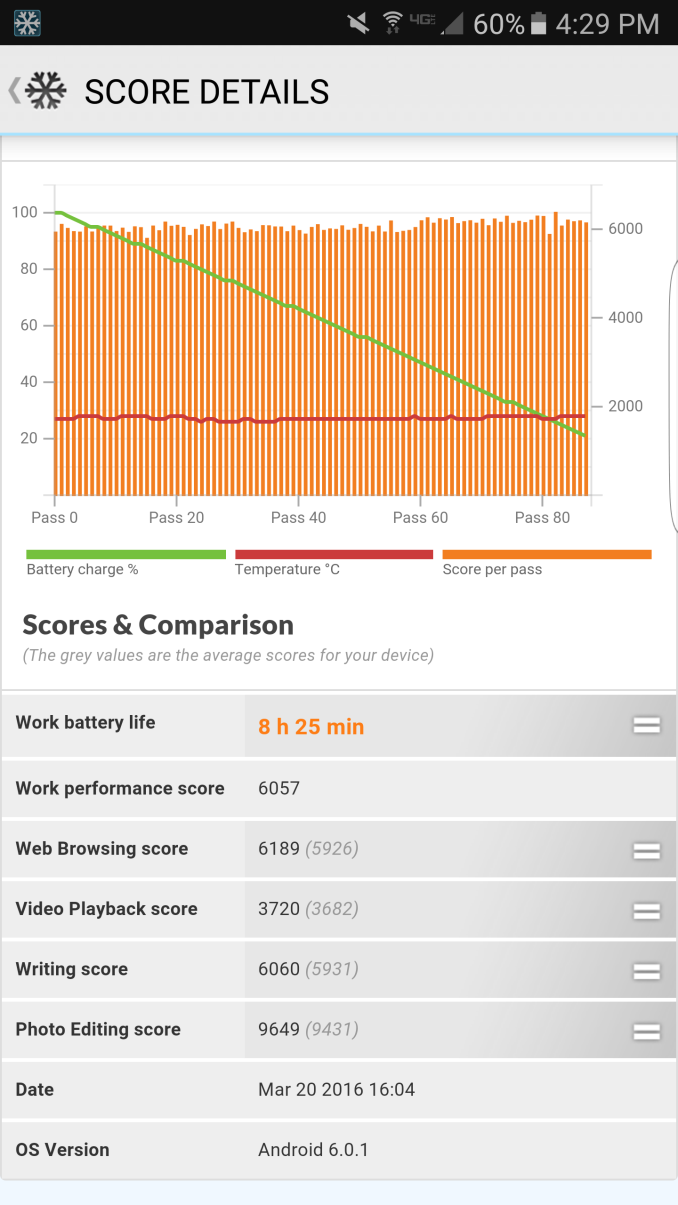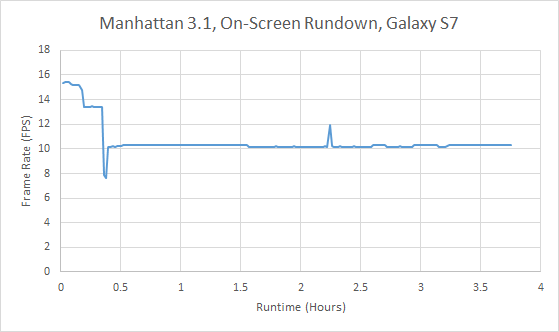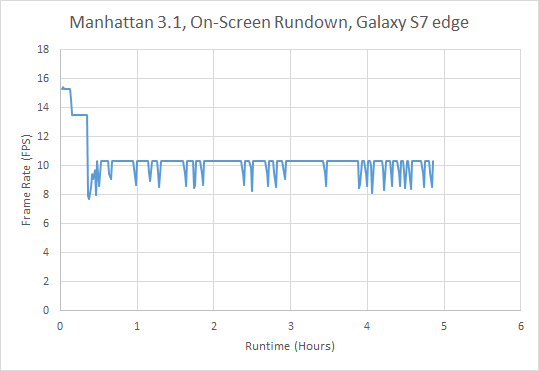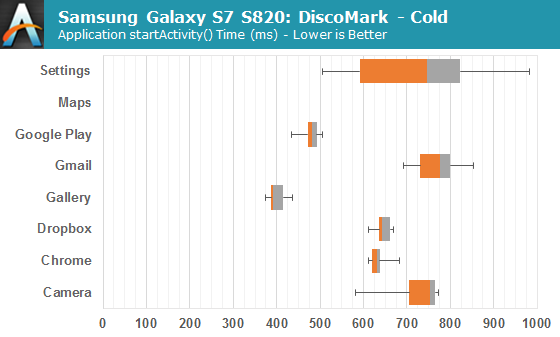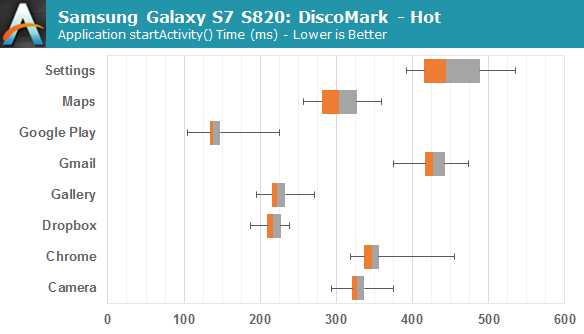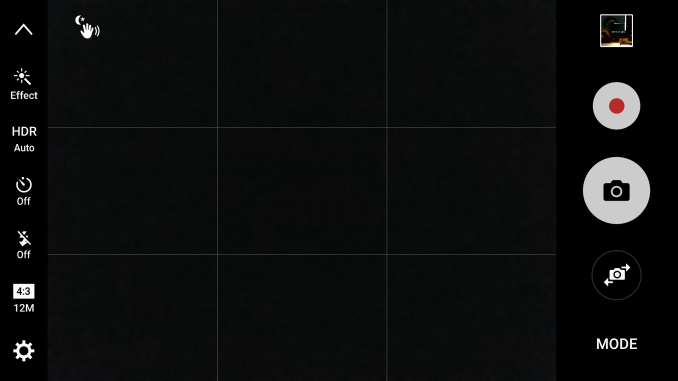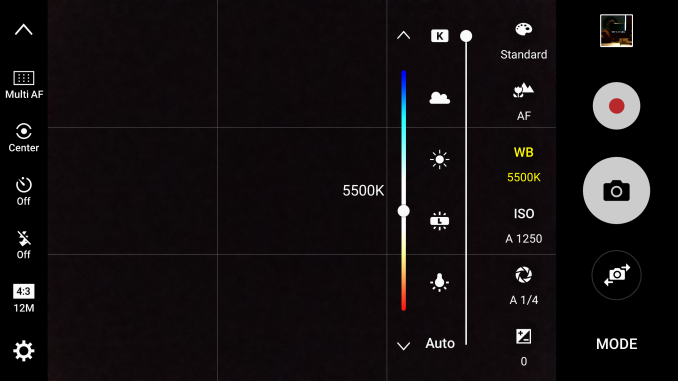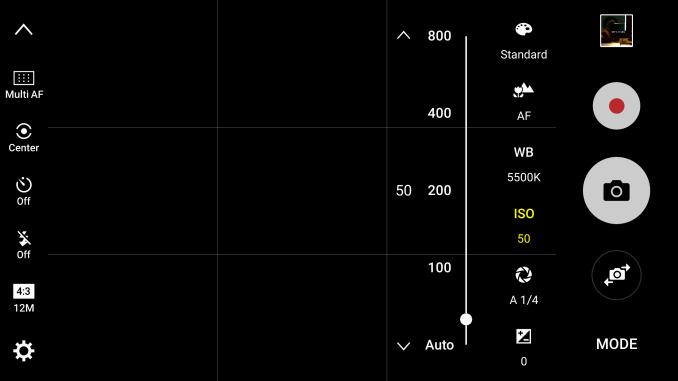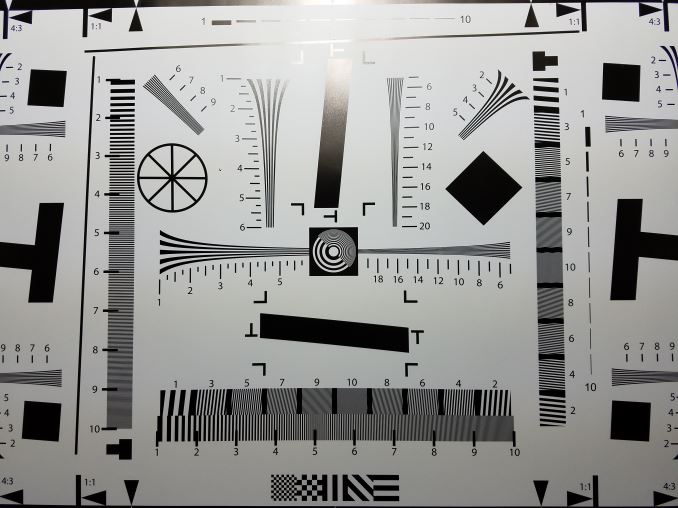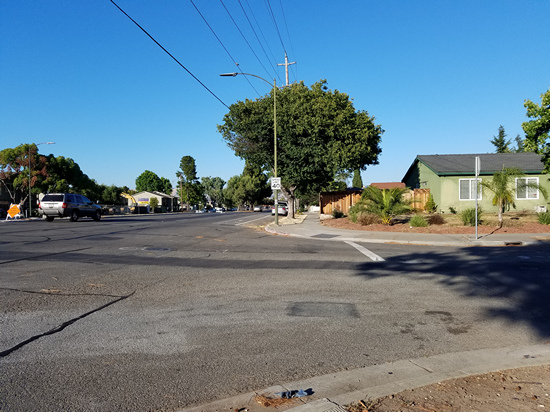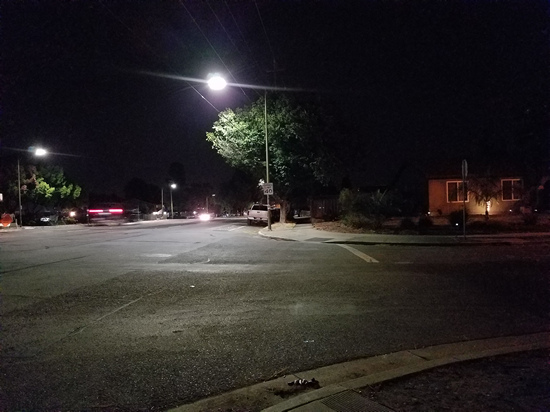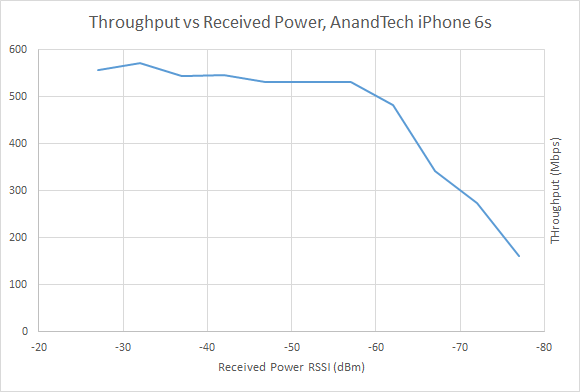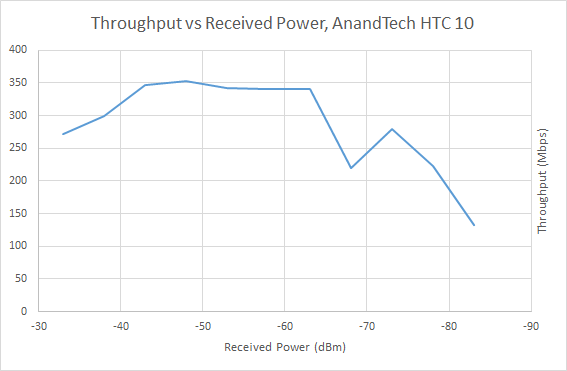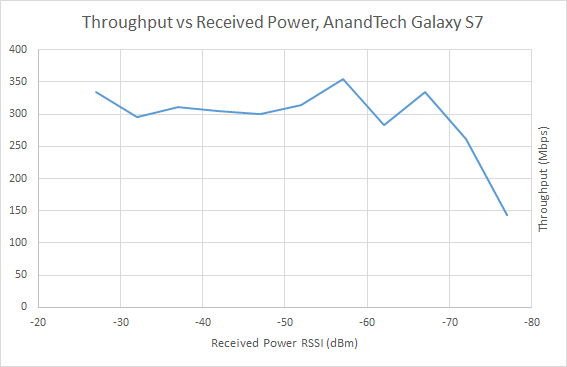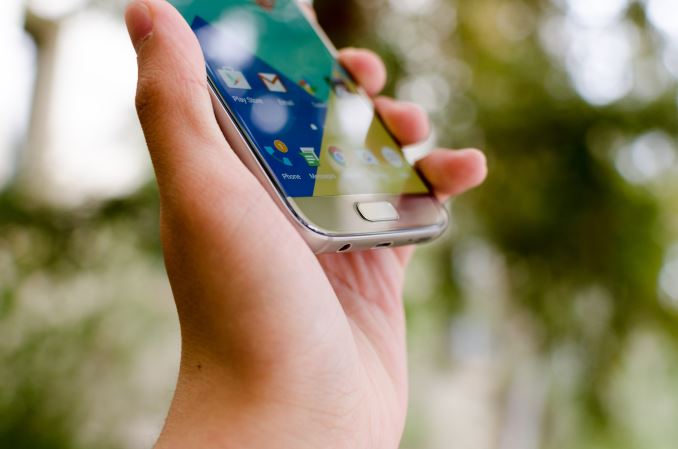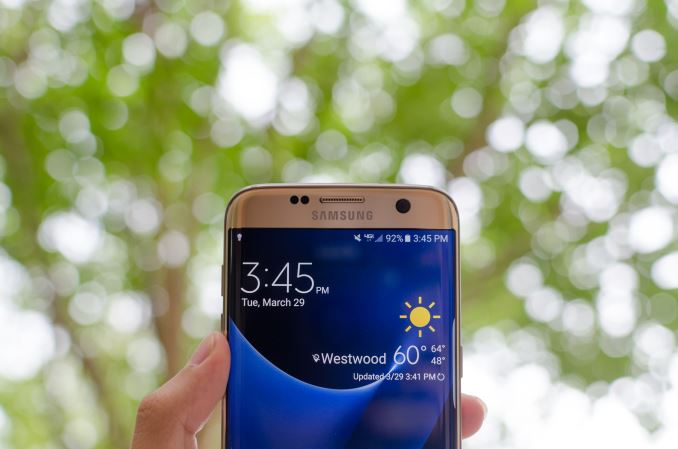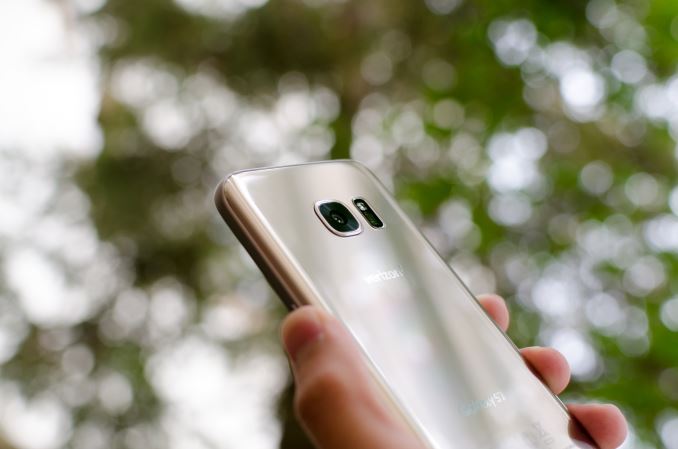
Original Link: https://www.anandtech.com/show/10196/the-samsung-galaxy-s7-and-s7-edge-review-part-2
The Samsung Galaxy S7 and S7 edge Review: Part 2
by Joshua Ho on July 5, 2016 8:00 AM EST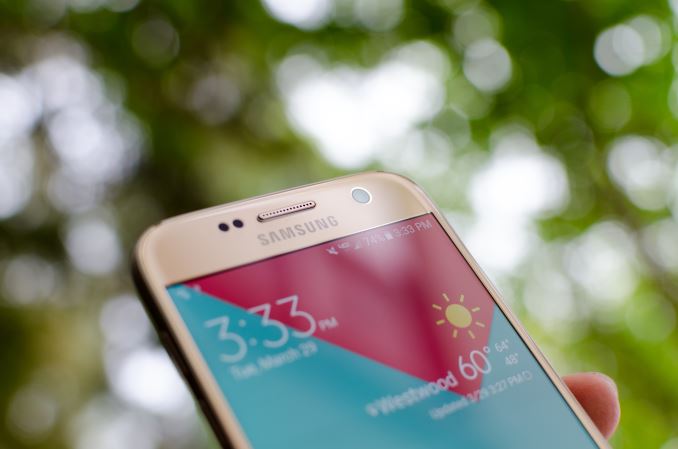
With part one of our Galaxy S7 review, it was clear that the Galaxy S7 was at least a mild improvement to the Galaxy S6 in some ways, but there were still many areas to investigate. At the time, we were in the middle of transitioning to our new 2016 benchmark suite, which meant that it was necessary to re-test the Galaxy S7.
Our 2016 benchmark suite attempts to really push our testing in general to a new level of depth and more importantly, more focused on the overall user experience. When reflecting upon the value of AnandTech from a testing perspective, it’s clear to me that while part of our value is running benchmarks across a wide range of phones, another part of our value is being able to run tests that others wouldn’t be able to run at all.
With our new test suite for 2016, our extended suite of benchmarks attempts to focus on the latter to go deeper in reviews in a meaningful way. I definitely enjoy examining architectural details through microbenchmarks, but for general reviews our standard test workflow needed to be focused on user experience in a deeper way. With this in mind, we can get into the data that we were missing with part 1 of the review. Of course, if you haven’t read part 1 of the Galaxy S7 review, I highly recommend reading it first just to get a better introduction into the basics of the Galaxy S7.
Battery Life
Of course, now that we have our full suite of benchmarks we can start to look over in detail how devices perform. While we’ve gone over some of the results before it’s probably fair to say that our discussion of battery life on the Galaxy S7 was woefully incomplete with part 1 of the review. It’s also worth noting that internally we were still working on our 2016 web browsing test at the time so it wasn’t necessarily complete and sufficiently consistent and accurate. In the time since, we’ve been able to get all of the bugs ironed out and get a test that provides useful data that our previous tests didn’t.
As battery life is a critical part of our testing, it’s important for us to get this right, and in order to get useful relative comparisons we have to make sure that every device is tested in the same manner to avoid bias in one way or another. In order to achieve this, all devices have all possible background services disabled, as well as sync and automatic app updates. In order to try and make an even comparison we also set the display to 200 nits brightness on a 100% average picture level display, also known as a blank white screen. However, one area that we aren’t necessarily able to control for 100% of the time is ambient temperature, device orientation, or material contact. While tests that don’t reach TDP limits won’t see any effects, TDP-limited tests will see a delta here, but it’s hard to estimate just how much of an impact exists here.
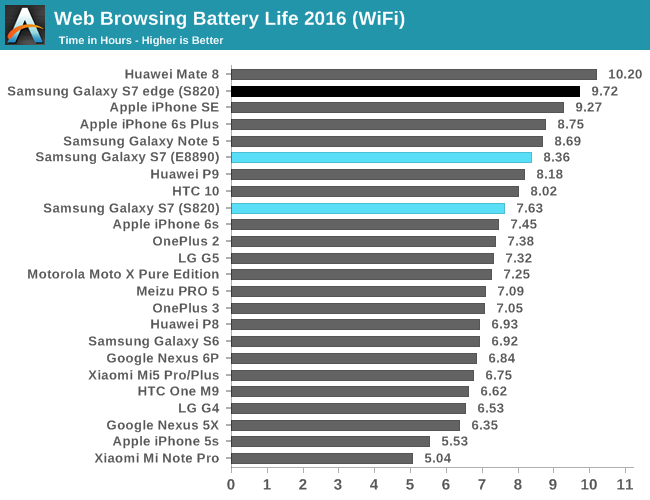
With this baseline in mind we can move on to the actual results. As seen in the chart above for WiFi web browsing on our new test it’s worth mentioning that the data here has changed as changes to the test have affected results, generally bringing battery life down or keeping it around the same. The Galaxy S7 does fairly respectably here, although the Snapdragon 820 version is definitely showing either architectural or implementation inefficiency here when compared to the Exynos 8890. A delta of about 10% means that the Exynos 8890 GS7 uses about 1.38W average here while the Snapdragon 820 GS7 uses about 1.51W in this test assuming that the battery capacity is nominal. If you subtract out an estimated display power the delta that can be attributed to non-display factors is something like 30% here. Interestingly, the HTC 10 is mildly more efficient here with its higher density LCD, with the AMOLED display consuming something like 10% more power despite the presence of dark-themed webpages to try and bring some balance here. The Galaxy S7 edge is pretty much the top here, but achieves its battery life through sheer battery size rather than efficiency.
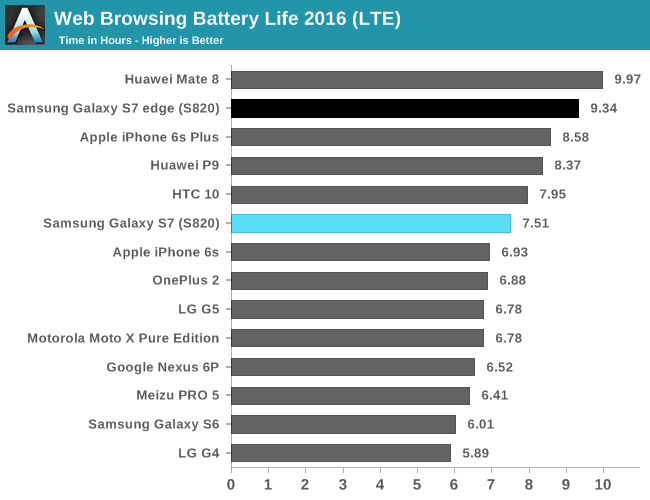
Moving on to LTE we can really start to see the battery life advantage that the Snapdragon 820 brings. It turns out that as a communications company, Qualcomm is good at making radios. One of the most obvious ways that this shows is in power, as the Snapdragon 820 basically has the same battery life whether you’re on LTE or WiFi, which isn’t necessarily the case with other devices. Unfortunately, we haven’t been able to test the Galaxy S7 with Exynos 8890 in comparable conditions for LTE so we can’t really see how power of the S820 modem compares with the Exynos’ Shannon modem, but we continue to see that the Galaxy S7 S820 is a bit behind the HTC 10 in battery life due to the use of an AMOLED display in high-APL workloads. However, the difference is nowhere near what it was in the past, and is close enough to not really make a huge difference. The Galaxy S7 edge performs well here, but on the basis of its battery size rather than efficiency.
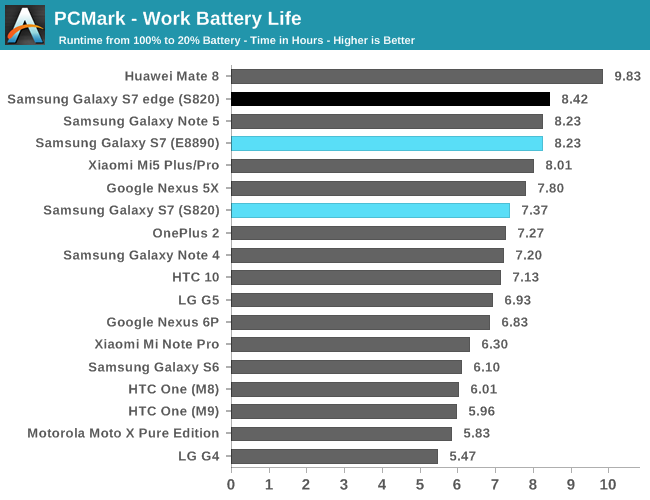
In the interest of not just relying on our own web browsing tests to try and get a handle for what battery life is like in general purpose compute situations, we continue to use PCMark’s battery life test to see how performance is in a benchmark that doesn’t attempt to equalize the amount of work done per unit time. Here the Galaxy S7 actually seems to be a fair bit better than the HTC 10, but this is likely due to the previously mentioned binning differences and some differences in governor as the delta in power and performance isn’t really all that much. The Galaxy S7 edge extends the lead here, again mostly due to the larger battery as the two devices are generally quite similar to each other.
Moving on to throttling performance we’ve transitioned to GFXBench’s Manhattan test on infinite rundown instead of T-Rex for this year as some devices from certain vendors have a tendency of reaching vsync on T-Rex which meant that it was difficult to see just how much throttling occurred over the duration of the test. After some testing it’s evident that for the most part throttling behavior is not necessarily changed by Manhattan either, so there’s not much need to retain T-Rex for high-TDP tests. Basemark OS II’s battery life testing is also rather questionable at this point, so we will no longer be reporting these scores as the methodology isn’t up to par with our expectations for 2016 and beyond.
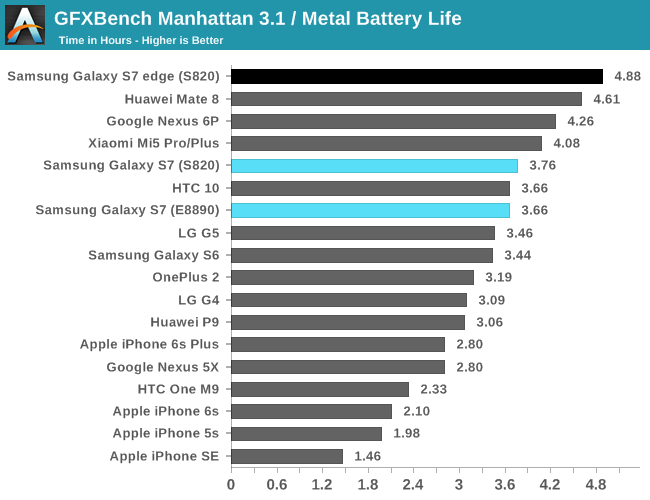
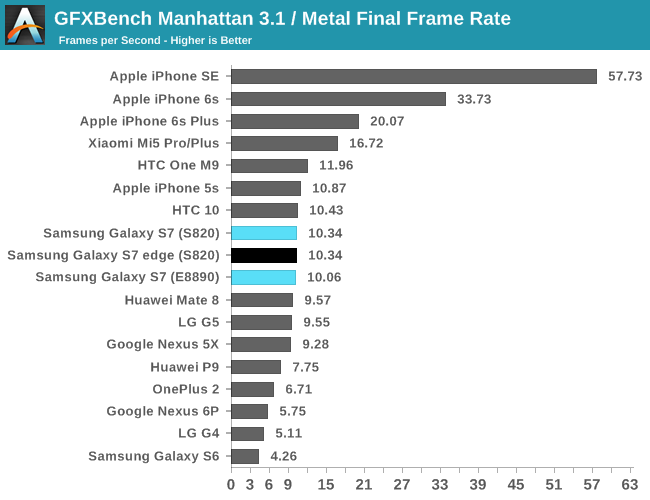
In the case of Manhattan, we continue to see some of the sinusoidal behavior seen in T-Rex throttling as it seems that Samsung’s throttling algorithms tend towards a more underdamped behavior than critically damped like HTC’s. However, for whatever reason it looks like the Galaxy S7 edge ends up with similar oscillating throttling behavior. Interestingly enough, even though the Galaxy S7 spends more time at higher performance states than the HTC 10, it manages to last longer, which is likely due to the lower APL of this content in conjunction with forced power save modes, and higher sustainable skin temperatures due to the glass back with heatpipe cooling to help distribute heat. Of course, the Galaxy S7 edge manages to last longer than either due to its larger size and battery.
Overall, the Galaxy S7 has decent battery life, while the S7 edge has great battery life due to its relatively large battery compared to its display size. The improvements here aren’t necessarily going to blow you away unless you get the Exynos 8890 variant, but it’s good to see that we’re finally back to improving on battery life with the launch of the Snapdragon 820 compared to the Snapdragon 810 and 808’s rather disappointing power efficiency due to the use of a high-power implementation and process node. I’m not sure the Snapdragon 820 is really the best design we’ve seen on 14LPP when it's more on par with 14LPE SoCs for efficiency, but it’s good enough that it doesn’t fundamentally compromise a device.
System Performance Revisited
Now that we’ve covered battery life we can revisit another topic where our testing has changed dramatically for 2016, which is our system performance benchmarks. As previously mentioned this year a major goal of ours was to focus on benchmarks with metrics that better indicate user experience rather than being subject to additional layers of indirection in addition to updating our previously used benchmarks. Probably one of the hardest problems to tackle from a testing perspective is capturing what it means to have a smooth and fast phone, and with the right benchmarks you can actually start to test for these things in a meaningful way instead of just relying on a reviewer’s word. In addition to new benchmarks, we’ve attempted to update existing types of benchmarks with tests that are more realistic and more useful rather than simple microbenchmarks that can be easily optimized against without any meaningful user experience improvements. As the Galaxy S7 edge is identical in performance to the Galaxy S7, scores for the Galaxy S7 edge are excluded for clarity.
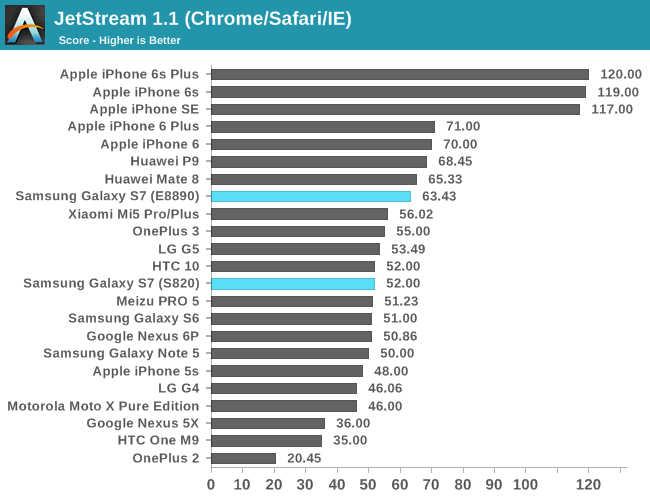
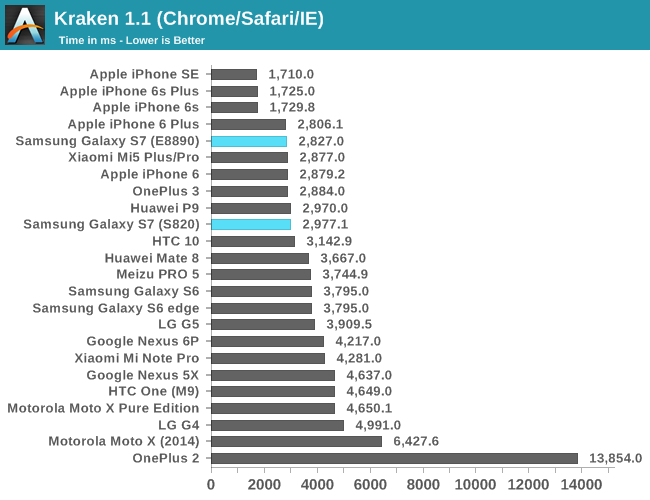
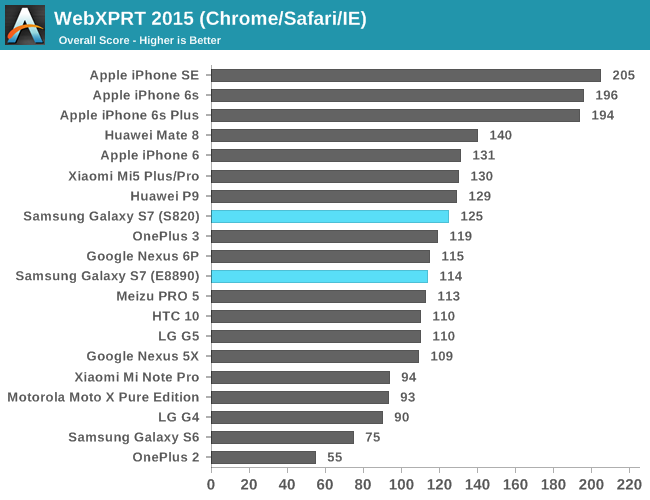
In browser/JavaScript performance the Galaxy S7 in its Snapdragon 820 variants performs pretty much as you'd expect with fairly respectable performance about on par with the iPhone 6 at least part of the time, which frankly still isn't enough but a lot of this is more due to Google's lack of optimization in Chrome than anything else. The Exynos 8890 version comes a lot closer but it still isn't great. Subjectively browsing performance on the Galaxy S7 with the Snapdragon 820 is still painful with Chrome, and I have to install either a variant of Snapdragon Browser or Samsung's stock browser in order to get remotely acceptable performance. Even then, performance isn't great when compared to Apple's A9-equipped devices. The lack of single thread performance relative to other devices on the market in conjunction with poor software optimization on the part of Google is really what continues to hold OEMs back here rather than anything that Samsung Mobile is capable of resolving.
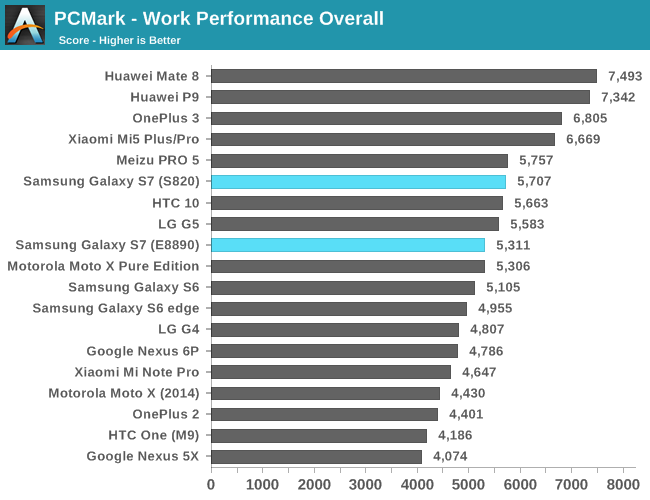
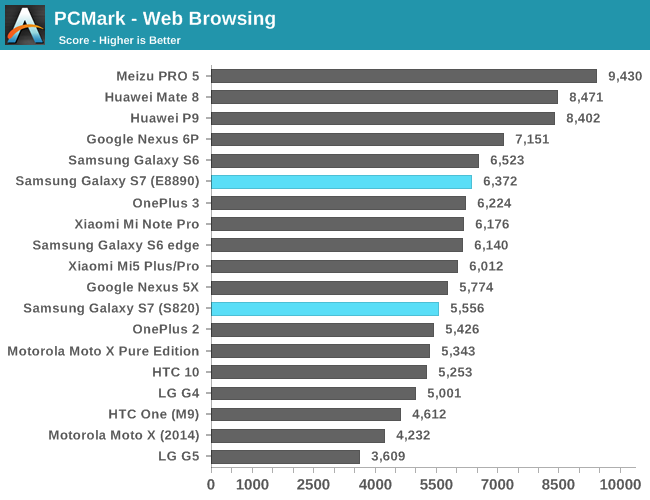
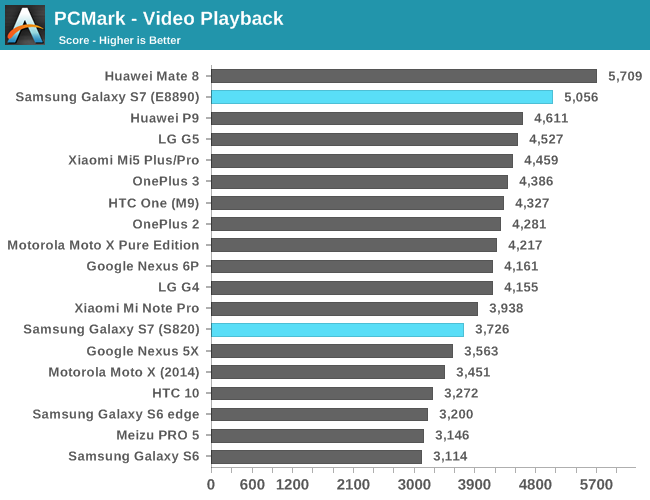
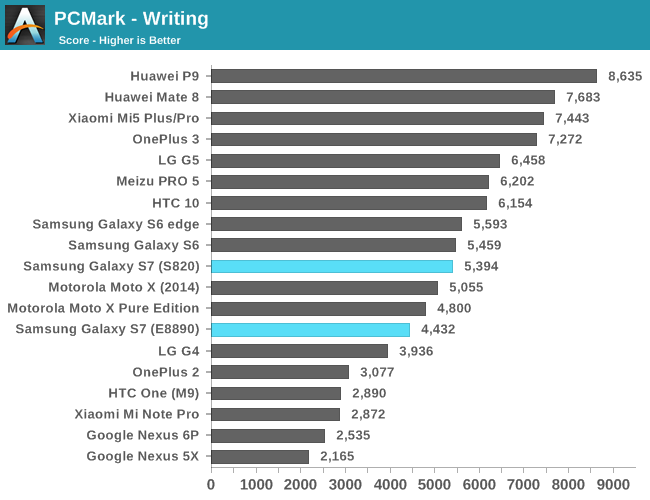
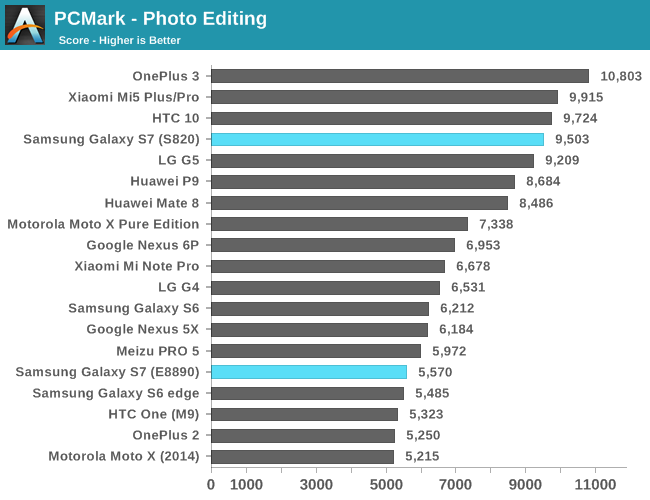
PCMark shows that the Galaxy S7 is generally well-optimized, with good performance in native Android APIs, although devices like the OnePlus 3 pull ahead in general, likely due to differences in DVFS, lower display resolution, more RAM, and similar changes as the hardware is otherwise quite similar. In general though unless you get something with a Kirin 95x in it you aren't going to get performance much better than what you find in the Galaxy S7, although the software optimization in cases like the writing test could be better for the Snapdragon 820 version of the phone.
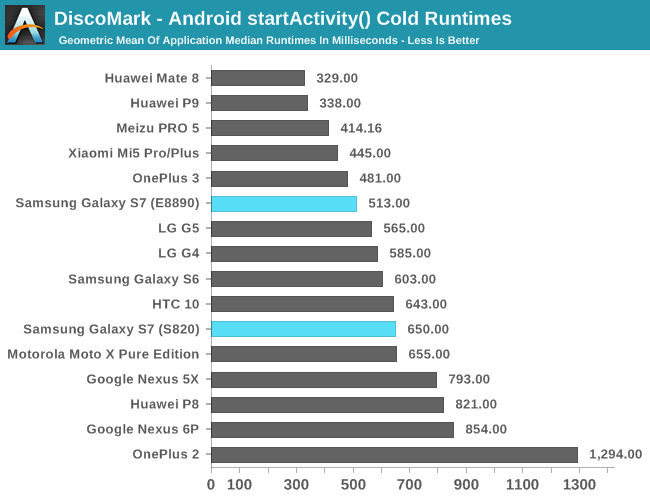
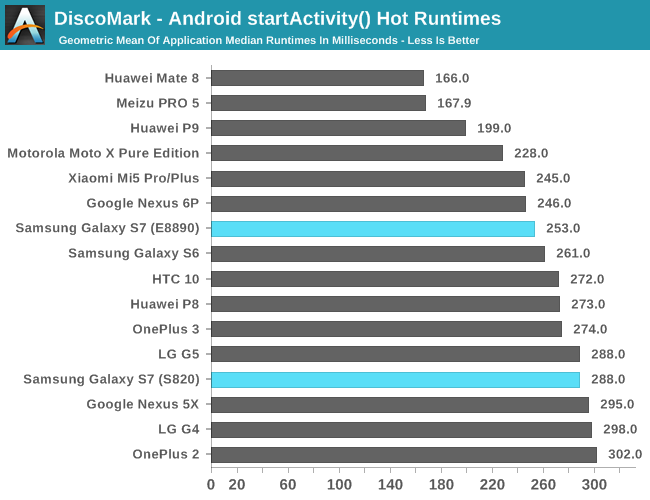
As hinted by the PCMark results, the Galaxy S7 with the Snapdragon 820 is really nothing to write home about when it comes to actual software optimizations, while the Exynos 8890 version is significantly faster in comparison. The fastest devices by far here are still the Kirin 950-equipped phones, but even from cold start launches the HTC 10 is comparable, and pulls ahead slightly when the applications are pre-loaded into memory. The OnePlus 3 and Xiaomi Mi5 are closer to what the S820 GS7 should be achieving, which is really more a testament to just how strangely slow the Galaxy S7 with Snapdragon 820 is.
Overall though, the Galaxy S7 in both iterations are acceptably fast for general purpose tasks. However, with that said the Snapdragon 820 variant is noticeably slower, and the software stack seems to be less optimized for whatever reason even after multiple post-launch OTAs and all the latest app updates. Given that these devices have locked bootloaders it's difficult to really go deep and try to figure out exactly what's causing these issues, but it's likely that Samsung Mobile has the engineering staff to do this and resolve these issues as a 600 USD phone really shouldn't be performing worse than a 400 USD phone. On the bright side, the Exynos 8890 variants perform quite well here, with performance comparable to top devices and often beating out Snapdragon 820 devices, although usually not by a huge margin.
System Performance Cont'd
Now that we've gone over the more general purpose system benchmarks we can focus on new benchmarks that emphasize GPU performance much more strongly. For the most part we haven't had huge issues here like we've had with good CPU and general performance benchmarks, but it's important for us to keep our benchmarks up to date in terms of workload balance and overall performance.
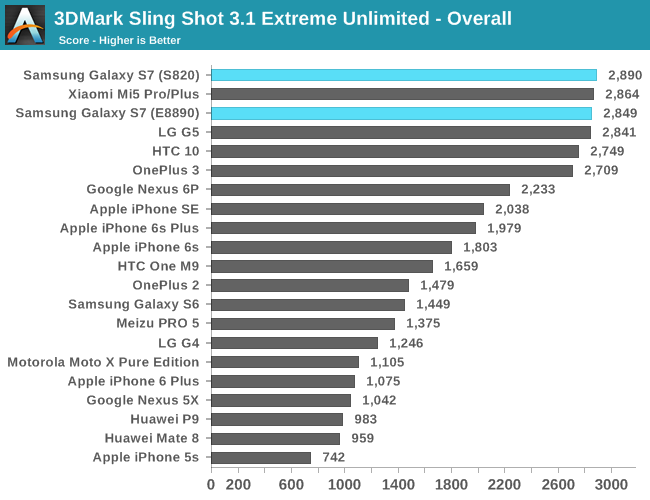
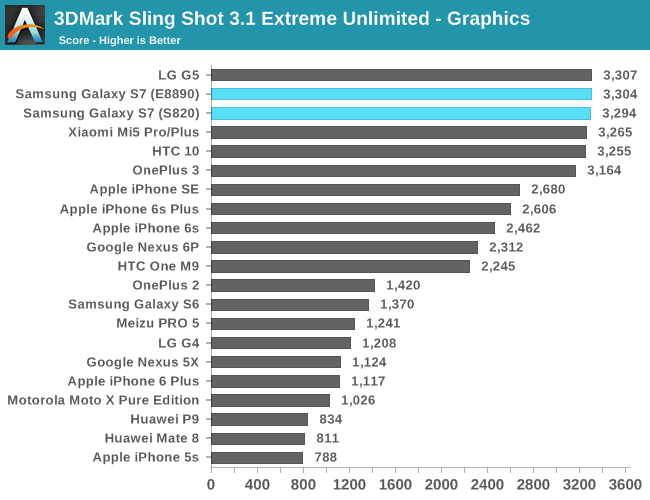
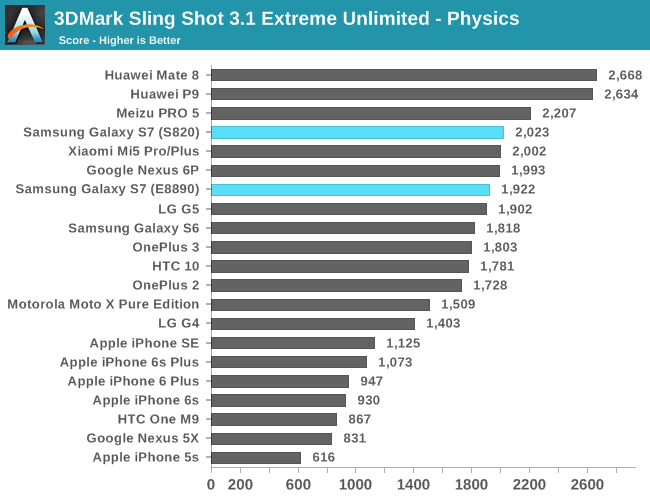
One of our first new benchmarks designed to better test the GPU is 3DMark's Sling Shot ES 3.1 test, which is designed to test a GPU's performance when the application is either using OpenGL ES 3.1 or Metal. As one can see, the Snapdragon 820 and Exynos 8890 have basically comparable GPU performance in this test and in the physics test as well. Once again we're seeing how core count and clock speed are basically the primary determinants of performance in the physics test when the device isn't strongly limited by thermals. I wouldn't draw any real conclusions from this as generally game CPU code can extract ILP unlike what we're seeing in this test.
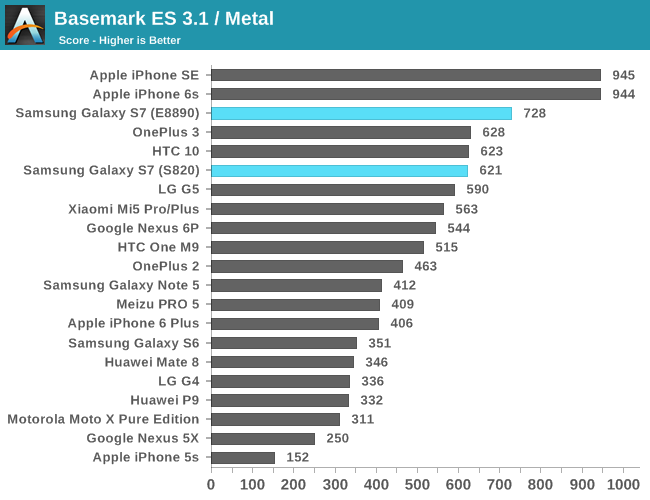
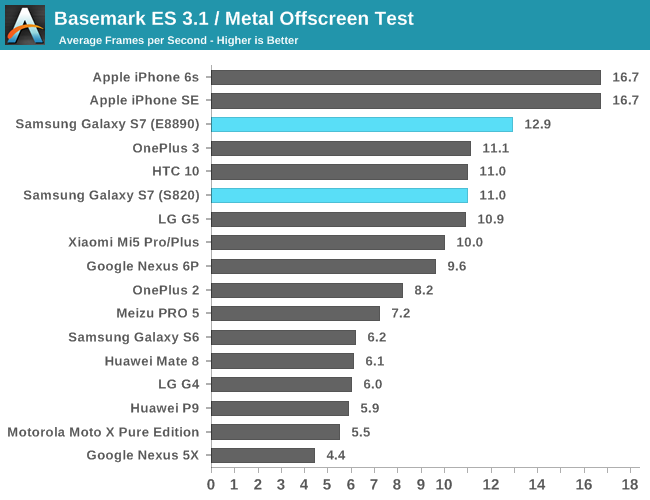
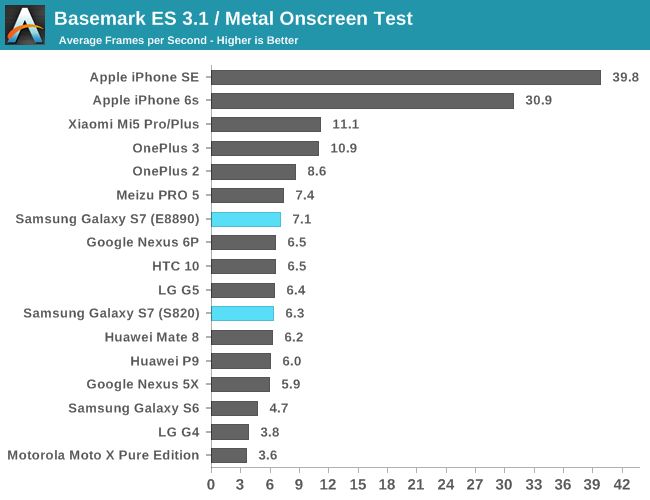
In this test we start to see that the Mali GPU in the Exynos 8890 and the PowerVR GPU in the A9 are providing a noticeable advantage over the Snapdragon 820's Adreno 530 to a noticeable extent.
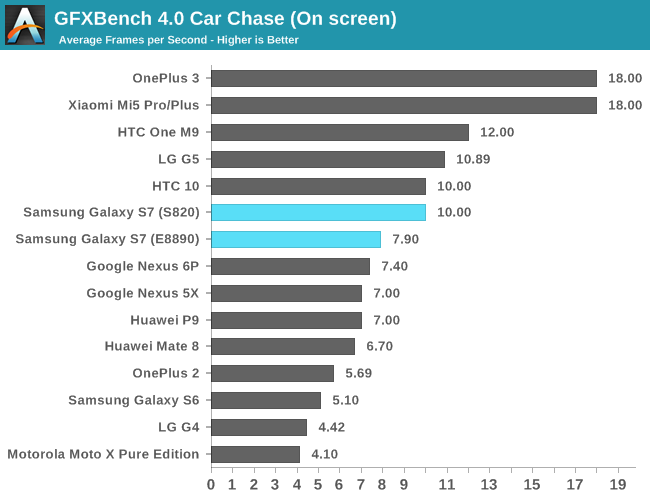
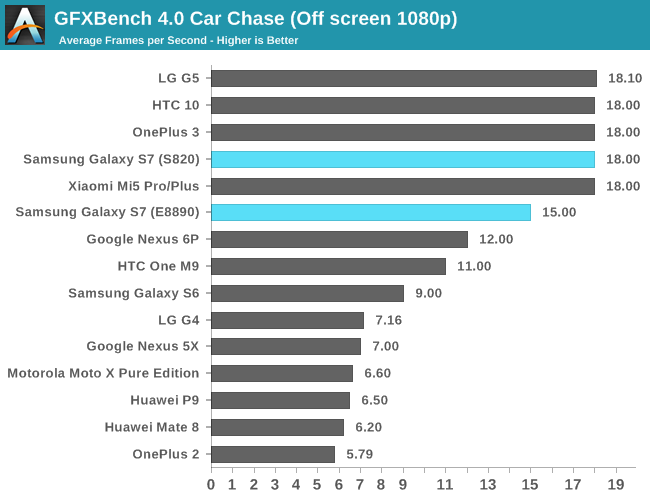
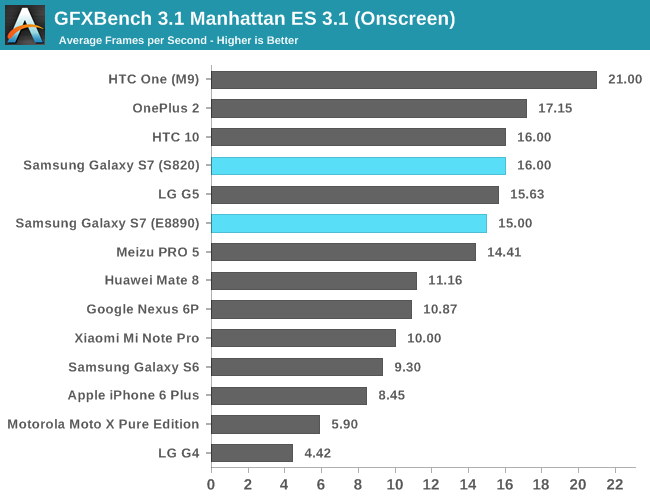
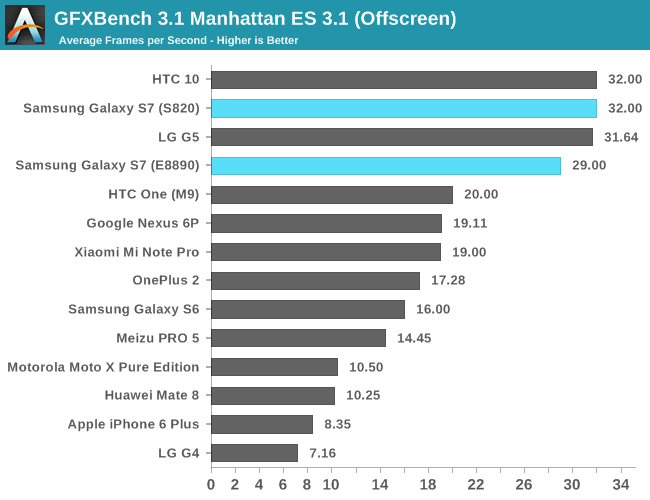
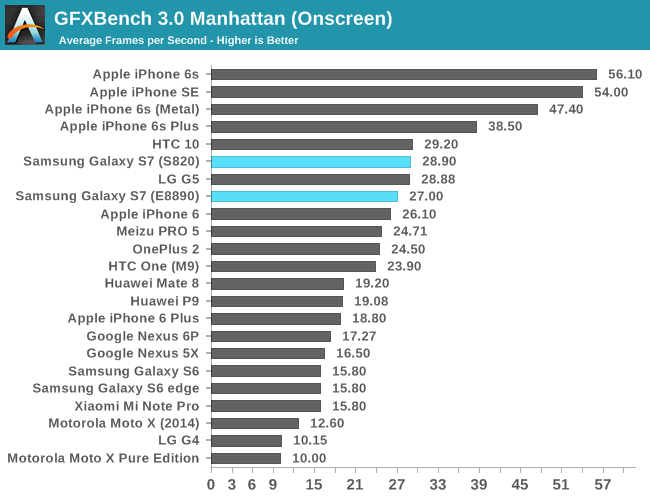
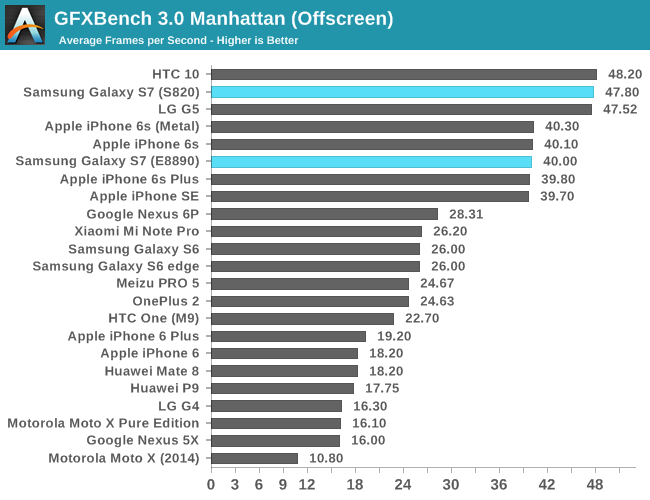
With GFXBench we can see that in Car Chase and Manhattan the Adreno 530 actually manages to pull away. However, because we have basically zero architecture disclosure on the Adreno 530 there's really no way for us to explain what's going on here and why. The reasons for the difference in performance could be related to drivers or architecture or architecture implementation and in the absence of information it's probably best to avoid making blind guesses. Regardless of these details, the Snapdragon 820's GPU should be more than enough for playing the latest games, but unless you use Samsung's automatic game optimizer system to set render resolution to 1080p it won't do as well as the iPhone 6s but given that most Android games target a much lower spec level it's likely that you won't have any problems given that the Adreno 530 is on the bleeding edge for Android SoCs.
Camera Architecture and UX
In general, camera has become probably the single biggest point of differentiation between smartphones at this point. As smartphones are often the only camera that most people carry on a day to day basis, the rear camera on a smartphone really cannot be a disappointment relative to the competition. While we can talk about how much a front-facing camera matters in terms of quality, it’s pretty safe to say that for photos and videos that are worth saving will be taken with the rear-facing camera.
While post-processing and a number of other factors are going to have a huge impact on the overall camera experience, the foundation that makes it possible to deliver a great camera is always going to start at the hardware.
| Samsung Galaxy S Cameras | ||||
| Galaxy S6 Galaxy Note5 |
Galaxy S7 | |||
| Front Camera | 5.0MP | 5.0MP | ||
| Front Camera - Sensor | Samsung S5K4E6 (1.34 µm, 1/4.1") |
Samsung S5K4E6 (1.34 µm, 1/4.1") |
||
| Front Camera - Focal Length | 2.2mm (22mm eff) | 2.1mm (21mm eff) | ||
| Front Camera - Max Aperture | F/1.9 | F/1.7 | ||
| Rear Camera | 16MP | 12MP | ||
| Rear Camera - Sensor | Sony IMX240 Samsung S5K2P2 (1.12 µm, 1/2.6") |
Sony IMX260 Samsung S5K2L1 (1.4 µm, 1/2.6") |
||
| Rear Camera - Focal Length | 4.3mm (28mm eff) | 4.2mm (26mm eff) | ||
| Rear Camera - Max Aperture | F/1.9 | F/1.7 | ||
In the case of the Galaxy S7, Samsung has done something that I thought they’d never do, which is move backwards in resolution in order to improve pixel sensitivity. In the case of the Galaxy S7, Samsung has moved from the Sony IMX240/Samsung S5K2P2 to the Sony IMX260/Samsung S5K2L1 sensor, with a 1.4 micron pixel size relative to a 1.12 micron pixel pitch in the previous generation. This means that there’s a 56% increase in sensitivity per pixel. Assuming the same process technology, this does improve low light performance significantly. While to some extent it’s true that improved CIS (CMOS image sensor) technology can alleviate the downsides of smaller pixels, on the same technology you have to reduce your fill factor/active sensor area. The other problem is that while read noise on the sensor does reduce per pixel as you reduce pixel size, the overall sensor read noise trends upwards. This means that the region in which the CIS noise is primarily limited by shot noise is going to be smaller as you reduce pixel size. Shot noise is an unavoidable reality of existence, to the extent that even our eyes can see this “visual snow” if ambient light is sufficiently dim.
However, in the case of the Galaxy S7 I suspect that there’s more to the story, because the dual pixel AF system means that for each 1.4 micron pixel each pixel needs two photodetectors. In order to make phase detection work, there has to be sufficient spatial separation to make this system work properly, so some of the benefit of these larger pixels will inevitably be eaten up in order to enable PDAF that works in basically all lighting conditions.
The other notable change here is that the Galaxy S7 uses an even wider f/1.7 aperture. Unfortunately, in Samsung's efforts to try and make the module thinner they've made the focal length slightly shorter than before which results in an effective focal length of 26mm. This and the wider aperture could lead to compromises as light is entering the optics at a more extreme angle than before.
With these basics covered, we can move on to a discussion of the user experience. While in the past it was easy enough to just take some still shots on a tripod, a holistic view of camera quality really needs to take into account far more than just the end result. A poorly designed camera application with low resolution, low frame rate preview, improper preview aspect ratio, poor control layout, and other issues can easily make it difficult, if not impossible to get the photo that you want. These issues are thankfully getting less common, but these problems can make it almost impossible to recommend a phone for its camera, no matter how good the results are.
In the case of the Galaxy S7, the camera application is a nice upgrade over the Galaxy S6 at launch, but for the most part nothing is really different this go around. I’m not going to spend too much time here, but the short story is that I don’t think that Samsung is doing anything wrong here, and things are pretty much as good as they’re going to get.
While leaving it at that would be enough, I want to recognize some of the improvements that Samsung has implemented here. The major improvement here is that Pro mode is finally useful, as this mode now allows for adjusting auto-exposure and AF targets, in addition to EV, shutter speed, ISO, white balance with 100K granularity, and manual focus. The one notable shortfall here is that Samsung only allows 800 ISO max in manual ISO mode when the true maximum is 1250. For better or worse though, that’s the only notable problem I encountered with the camera app itself. It’s easy to think that Samsung hasn’t done anything notable here, but this is more a testament to the execution of design more than anything else.
However, before we move on to image quality testing, we can take a look at our focus and capture latency tests. For those that are unfamiliar, this is a fairly simple test designed to see how long it takes for a phone to focus and capture a scene on our standard ISO test chart in good lighting conditions, which can give a fairly good idea for best case latencies.
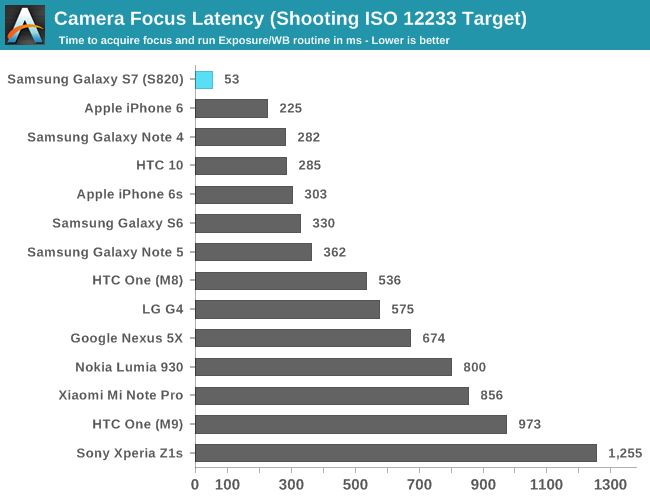
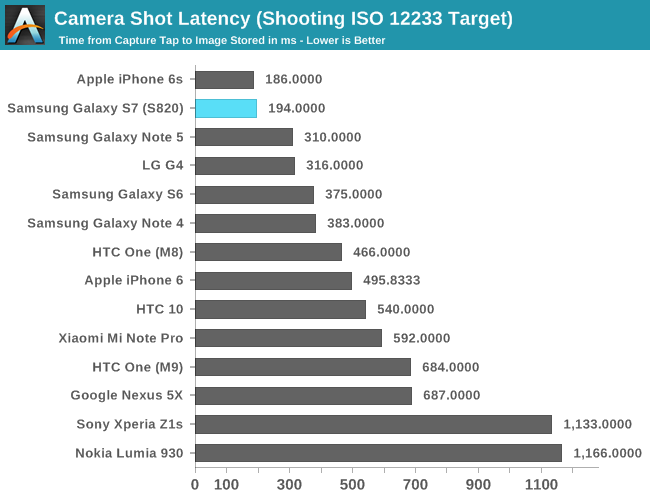
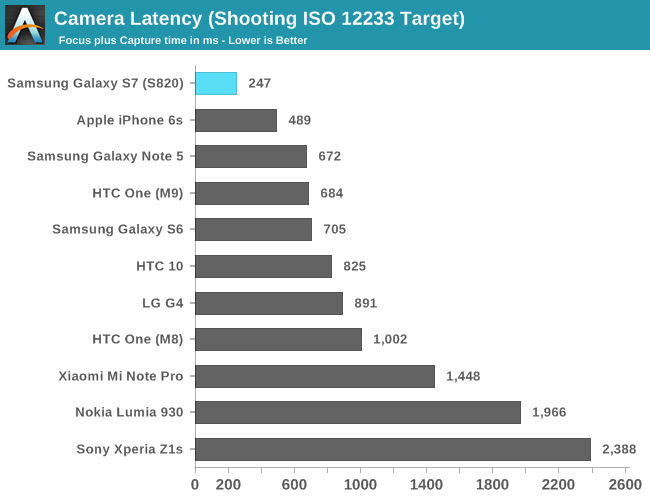
It’s probably not a surprise, but the Galaxy S7 is really, absurdly quick to take photos and focus. There is nothing out there that can realistically match the dual pixel AF system in the Galaxy S7, especially once you get into low light scenarios where traditional PDAF systems are overwhelmed by noise that can’t be easily canceled out. Samsung’s sheer prowess in semiconductor design and manufacture is really showing here, even in the best case.
Still Image Performance
Now that we’ve covered the user experience associated with the camera, we can start to go over the output that the Galaxy S7 is capable of producing. In order to do this we continue to carry over the same sorts of benchmarks that we’ve used in 2015, which is to say that we use a combination of standardized test charts with semi-controlled lighting along with real world testing to try and see how the device actually performs outside of rather simplistic tests.
Starting with the ISO chart we can see quite clearly that the Galaxy S7 has lost noticeable ground in resolution relative to the Galaxy S6 when you look at the center of the photo, but at the edges of the photo the Galaxy S7 actually appears to have the lead against the Galaxy S6. The same sort of story plays out with the HTC 10 as it clearly has more detail than the Galaxy S7 at the center of the photo but the edges of the HTC 10’s test chart shot shows clear defocus that gets pretty terrible at the corners.
| Daytime Photography |
In our daytime landscape test we can see the sorts of effects that the smaller pixel size has had on the Galaxy S7. Relative to the Galaxy S6, there’s almost no delta in the detail resolved, but right away it’s obvious that the sharpening halos have become even more obvious than before which is concerning. These observations also apply to the Galaxy Note5, although the Note5 is a bit sharper due to some changes in image processing relative to the Galaxy S6. However I wouldn’t say that there’s an appreciable difference one way or another here.
Relative to the iPhone 6s, the Galaxy S7 is basically identical in detail as well, but the iPhone 6s tends a bit warmer and has much, much less obvious post-processing that is extremely obvious on the distant trees that contrast against the sky. This is actually kind of surprising for me given that the Galaxy S7 has a larger sensor, but I suspect the dual pixel AF, wider aperture, and slightly wider field of view are eliminating whatever advantages increased sensor size might bring.
Compared to the HTC 10, the Galaxy S7 has better edge contrast, but generally it looks like textures have better detail on the HTC 10. I haven’t been able to do extensive RAW comparisons yet but it looks like HTC is just blurring luminance noise out too aggressively here for whatever reason. I’m not sure what causes this in image processing, but given how other OEMs like LG and Apple are fully capable of mostly eliminating color noise from their photos while retaining most of the detail that their cameras are capturing HTC would do well to do the same.
The final point of comparison I want to make here is the LG G4/G5. Although the G5 seems to have started an AF run in the middle of the capture, the areas where the photo is actually focused are arguably better than what the Galaxy S7 can put out. Even next to the G4, the Galaxy S7 falls short. I’m honestly not sure why LG doesn’t get more credit here, because next to Apple they seem to have the best image processing algorithms in the industry.
| Low Light Photography |
While daytime quality is critical, I suspect most people are going to be interested in low light performance as this is usually the hardest test for any OEM to get through. It’s taken years for OEMs to start shipping acceptable image processing in low light that wasn’t just a smeary and oversharpened mess, so getting this right is pretty important to say the least.
Unfortunately, the Galaxy S7 is just a bit disappointing here. The LG G5 is just clearly better here as noise reduction is better in pretty much every way and it looks a lot more natural due to less obvious sharpening halos. I would also argue that the HTC 10 is also better here due to its better texture detail and better handling of shadow detail, even if edges are softer.
The Galaxy S7 also has this strange streaking light flare with bright sources that I just couldn’t get rid of despite wiping the lens multiple times with a clean cotton cloth, which was done for every phone in this test before taking the picture. In fairness, the Galaxy S7 is still the fastest camera out of everything in this test, but it comes at the cost of rather disappointing output for me. The Galaxy Note5 looks like it might even be slightly better than the Galaxy S7, which is a weird regression when the general idea of going to a larger pixel size is to get better low light performance. As alluded to earlier, the cost of the dual pixel AF system may be sensitivity due to the dual photodiodes and light barrier to generate a phase detection pixel. While this is just one test example I’ve spent a lot of time playing with the camera on the Galaxy S7 and in general its low light performance is fairly similar to what you see above. The only time where I really see the Galaxy S7 lead is in extreme low light conditions where everything is reaching ISO and shutter speed limits.
Overall, while the user experience of the Galaxy S7's camera is industry-leading, the Galaxy S7 represents a somewhat unfortunate sidegrade in camera quality at best. I would argue that Samsung has gone in the wrong direction with their camera processing as they seem to be relying on strong noise reduction and sharpening more than ever before. The Galaxy S7 also retains the oversaturated color rendering of the Galaxy S6. While I'm sure most people are happy with these results, Apple and LG tend to have more accurate color rendition with their cameras. While HTC doesn't quite nail color rendition, they are arguably closer to reality than Samsung is. Hopefully with their next device they manage to maintain their class-leading speed, but with better post-processing and overall image quality.
Video Performance
Of course, the other part of the overall camera equation is video performance, which provides unique challenges for OEMs as things like encoder performance may have to run for a theoretically infinite amount of time as opposed to the burst workload that a single photo represents. Frames also have to be committed by a hard deadline rather than completing at some point in the future which means that there is a hard limit on the number of clock cycles that can be spent before moving on to the next frame.
Other than these basic challenges, it’s also important to be able to handle things like hand shake and other types of motion as people use their smartphones in dashcam applications or simply just walking around. As a result a good camera should be able to properly stabilize the video in all of these situations. In order to test this we rely on a simple side by side camera rig that holds both cameras pointed at the same object in order to see how the same subject looks on two different cameras simultaneously.
| Samsung Galaxy S7 Video Encode Settings | ||||
| Video | Audio | |||
| 1080p30 | 17 Mbps H.264 High Profile | 256 Kbps, 48 KHz AAC | ||
| 1080p60 | 28 Mbps H.264 High Profile | 256 Kbps, 48 KHz AAC | ||
| 4K30 | 48 Mbps H.264 High Profile | 256 Kbps, 48 KHz AAC | ||
| 720p240 | 76 Mbps H.264 Baseline | 256 Kbps, 48 KHz AAC | ||
To start with the basics we can look at the encodings used by Samsung for the Galaxy S7. For the most part there's nothing too interesting here other than the 720p240 encoding, which uses AVC's baseline profile rather than the high profile. I suspect we’re looking at a limitation of the Snapdragon 820’s encode blocks here rather than a deliberate decision by Samsung to use the baseline profile, as the high profile provides better quality compression in every scenario. Given that the Snapdragon 820 version of the Galaxy S7 also has a time limit for 4K video recording that the Exynos version doesn’t I suspect that Qualcomm’s encode blocks are just not as capable as those shipping in the Exynos 8890 and Apple’s A9 SoC, which is interesting given how hard Qualcomm has pushed for a focus on parts outside of the CPU or GPU on an SoC.
| 1080p30 Video |
Regardless of SoC, it seems that Samsung has chosen fairly sane encode settings for their video, so we can move on to 1080p30 output. Samsung continues to have issues with stabilization here, which is weird when you consider the fact that the HTC 10 actually has zero problems with the sort of jerky OIS reset behavior that I’ve come to associate with Android phones. However, the HTC 10 has less dynamic range here and less detail, although it doesn’t have very obvious sharpening halos the way the Galaxy S7 does. In fairness to Samsung, they are clearly ahead of the LG G5 here in terms of overall detail and dynamic range, as well as better wind noise removal.
Relative to the iPhone 6s Plus, the Galaxy S7 actually maintains its detail lead, but the iPhone 6s Plus is just clearly better at stabilizing the camera properly, which seems to be a combination of OIS and EIS. The Galaxy S7 does have a video stabilization setting toggle, but it doesn’t really help here and it’s turned off by default.
| 4K30 Video |
Moving on to the 4K30 output we see some interesting changes, likely brought on by the previously mentioned Snapdragon 820’s image processing deficiencies. The HTC 10 seems to have smooth motion by using EIS and OIS together for 1080p30, but when recording 4K30 it goes away and we’re left with the familiar jerky behavior that occurs when OIS hits its travel stop. However for some reason in 4K the HTC 10 has noticeably better dynamic range and resolved detail becomes on par with the Galaxy S7. Colors are also slightly more realistic as the Galaxy S7 overemphasizes the effect of the sunset resulting in a bit too much yellow in the sky and in general. The G5 might have slightly better detail than the GS7 here, but in general it just does worse in terms of color reproduction and dynamic range, as well as stabilization. There’s also a lot more wind noise that can be heard.
Relative to the iPhone 6s Plus, the superior stabilization of the iPhone 6s Plus is evident, and next to the iPhone 6s Plus it becomes pretty obvious that Samsung is just oversaturating some colors to try and get higher contrast. However, detail on the Galaxy S7 is slightly better when you look at a video frame by frame, but not really enough to notice in general. Wind noise is also better suppressed on the iPhone 6s Plus.
| Slow Motion Video |
In slow motion the Galaxy S7 does have better detail and higher frame rate than the HTC 10, but still over-emphasizes the effects of the sunset on lighting. Relative to the iPhone 6s Plus detail is better, but again colors are more natural.
In video performance overall, the Galaxy S7 is respectable for an Android device, but next to the iPhone 6s Plus it’s not really the greatest. Even the HTC 10 has better color reproduction, better stabilization in 1080p30, and better audio. Overall I’m not really blown away by the camera on the Galaxy S7. I’m not sure how most people came to their conclusion that the Galaxy S7 is the best Android camera, but I suspect that the logic behind it may not be a sound heuristic. The Galaxy S7 is the fastest Android camera by far, but the results it puts out are not necessarily the greatest. The HTC 10 is actually better than the Galaxy S7 in a number of cases, although not necessarily all the time and is let down by its focus and capture latency. The G5 is just flat-out better in still photography, but worse in video. Like the HTC 10 it's somewhat slow as well, but only when compared to the Galaxy S7. If I had to weigh everything together I would argue that the HTC 10 and LG G5 are at least the equal of the Galaxy S7, although this is after both devices have had numerous OTA updates through the months since release. I suspect that at launch there may have been bigger deltas, but after release everything has basically evened out. The iPhone 6s Plus is still the most well-rounded, but this is basically on the basis of video performance in 4K and 1080p60. If these things don't matter the HTC 10 is the next best thing in my eyes due to the more natural post-processing, but if you don't worry about these things the Galaxy S7 is fine.
WiFi Testing with Ixia IoT
As previously discussed, RF testing has always been a major unknown to some extent because environmental factors make it extremely difficult to tell exactly what is going on with the system. I don’t think it really needs to be said but previous reviews and any controversy regarding the quality of RF has always lead to a ring of confusion and back and forth with no clear-cut answers, at least in the public domain. The Transformer Prime and Pixel C reception issues have all been cases where I’ve seen a lot of confusion over whether a problem really existed in the hardware, software, or with the end user.
Most people really don’t have any understanding of how wireless transmission works, probably because it’s not really something you can see. As far as I know, no one is capable of seeing radio waves, even at high frequencies like 60 GHz. Of course, the problem is that for quite some time our testing was also not really ideal for seeing the quality of an RF implementation. While iPerf does provide some useful data, free space testing means that we’re dealing with channel conditions that inherently cannot be controlled. As a result, the only sensible test we could do with iPerf was focus on maximum throughput in the best conditions we could provide. The only thing that this can highlight is the upper bound of efficiency for WiFi due to the carrier sense multiple access scheme in most cases, and rarely detects a whole class of problems that affect user experience on WiFi.
In order to test these things we’ve moved to using a proper testing system that is actually used by at least a few OEMs today, namely Ixia IoT. While we discussed the possibilities for testing, at this time due to the RF isolation chamber used we are limited to AP simulation only, so we can’t properly simulate clients in the channel without restricting ourselves to a single spatial stream for both the AP and client. This wouldn’t be a very useful test if set up in this manner as most devices today that we’re testing have support for two spatial streams, and many routers have three or even four spatial streams at this point.
The first set of results we can talk about that will be of interest is rate vs range. This is a fairly simple test at a conceptual level, as it simply tries to see how well a device can maintain its performance in the face of reducing signal to noise ratio for a given modulation and coding scheme. This is a good high level test of how well a device can maintain a connection as reception degrades. In this test the HTC 10 had an initial RSSI of -28 dBm while the GS7 was at -21 dBm and the iPhone 6s at -22 dBm, which allows us to calculate the path loss and determine the RSSI as a function of the transmit power.
The results of this test are interesting to say the least. Off the bat, every device had different RSSIs measured, so this meant that everything had different levels of path loss. The HTC 10 seemed to have the most path loss, while the Galaxy S7 and iPhone 6s were functionally identical. However it looks like RSSI is really an insufficient metric here because while the iPhone 6s was able to reach maximum throughput using NSS 2 MCS 8, the HTC 10 and Galaxy S7 did its best at NSS 2 MCS 4 or 5. I suspect this may be just due to placement as device positioning strongly affects MIMO as receive-side spatial correlation reduces the gains that MIMO can provide. Regardless, the HTC 10 somehow manages to beat the Galaxy S7 through much of the curve, but for some reason suffers from a reduction in throughput at higher transmit power. It's worth mentioning though that this test doesn't allow for testing of antenna gain or similar tests. Given various levels of futzing about with the device positioning in the test chamber I'm fairly confident that the Galaxy S7 is consistently better with regard to path loss, so even if it doesn't perform as well at a given RSSI it tends to have a higher RSSI than the HTC 10 by about 5 dBm which is fairly significant.
Finally, the other test that we can run at this time is the roaming latency test, which tests how well a device can hop from one access point to another as the received transmit power rises and falls. If you ever rely on WiFi to work as you walk around any building larger than a single apartment unit, you’re going to feel the effects of high roaming latency as VOIP calls or any real-time network application will either experience interruption or drop altogether if roaming is not implemented properly.
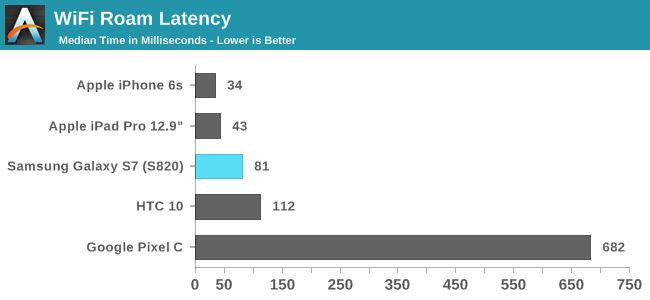
In the case of the Galaxy S7, roaming latency is honestly rather wanting. In the best case the Galaxy S7's roaming latency appears to be acceptable, but it's still significantly worse than the best we've seen so far. It seems that Samsung's algorithms have issues with edge cases as I've seen multiple instances so far where the device just can't handle roaming consistently. Despite consistent positioning and identical test setup I've seen cases where the Galaxy S7 has problems with consistent roaming. Even with the simple case of 10 dBm to -45 dBm at 3 dBm drop per second, I've encountered weirdness where the device drops from the network altogether claiming that the password given was incorrect (it wasn't) or a few successful handovers followed by getting stuck on a single access point or dropping from the network entirely. Even in the best set of trials performed I still saw 3 of 64 trials fail to roam correctly. The performance is certainly far better than something like the Google Pixel C, but Samsung should really be focusing on improving here.
Charge Time
While charge time is no longer much of a concern in light of how OEMs have made it a major priority in the last few product cycles, I still wanted to go ahead and verify its effects. Testing this is done with the usual method of monitoring until power draw at the outlet reaches a value approaching 0 to try and eliminate inaccurate battery percent reporting as a problem.
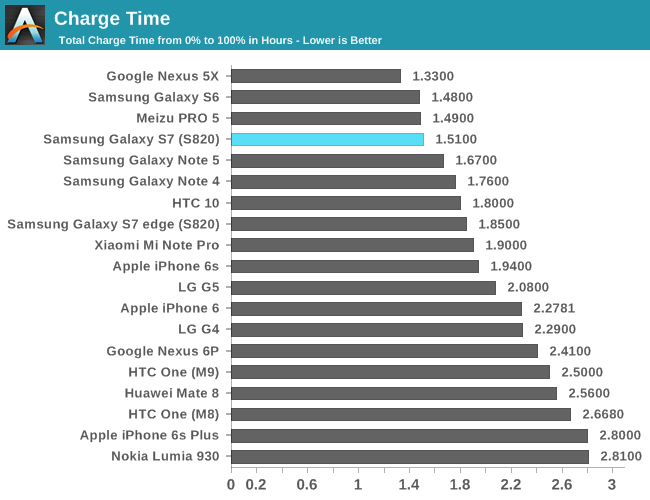
Interestingly enough, the Galaxy S7 charges faster than the HTC 10 here even though both have similar power output on their AC adapters. I suspect that we’re actually seeing the differences between QC 2.0 and QC 3.0 here as the environment in San Jose recently has never gone below 80F when testing. At any rate, the delta between the Galaxy S6 and S7 in charge rate is effectively not worth talking about, which isn’t really a huge surprise.
Miscellaneous
The miscellaneous section of each review is really just a list of comments that are too short to justify a separate section, but something worth discussing regardless. The first of these subjects is sound quality. While I don’t really have the ability to test 3.5mm output properly, I can say that the speaker output of the Galaxy S7 is weak without question. Maximum volume is quite low, and even ignoring that the quality of the output is nothing special with emphasis on higher frequencies. I suspect this is just the cost of waterproofing at work here.
The fingerprint scanner remains a Synaptics design win, and it generally works quite well. I like it a lot but it isn’t particularly fast or reliable the way the iPhone 6s’ TouchID is. I would say that it’s better than the iPhone 6’s fingerprint scanner, and is comparable with the HTC 10’s fingerprint scanner. However I do favor the HTC 10 fingerprint scanner design as it’s faster to just place a finger to the fingerprint scanner rather than pressing a button and waiting to scan, but the delta here is basically not worth talking about.
Samsung Pay is actually, finally available. Weirdly enough the magstripe transmission still has applications as places like Safeway seem to have completely ignored the liability transfer and continued using magstripe-only readers. Places like Walmart don’t seem to have NFC enabled despite moving to EMV which is strange to say the least. For the US, Samsung Pay actually does provide value, and turns paying from your phone from an occasional experience to a common one. For now at least, Samsung Pay has some real value which is good to see.
I haven't seen any real issues with GPS on the Galaxy S7, as OEMs have been taking this sort of thing seriously for a while. I don't think anyone is really going to face issues with GPS at this point, but it's worth mentioning just to confirm that this is the case.
Final Words
The Galaxy S7 in a lot of ways represents the sort of end game for the smartphone market, but before we get into these kinds of overarching discussions I want to recap everything we’ve learned about the Galaxy S7 before we get into the conclusion in earnest, which includes part 1 of this review.
We can start with design, where the Galaxy S7 shows quite a bit of resemblance to the Galaxy S6, with clear influence from the Galaxy Note5. Ergonomically the Galaxy S7 is just a step up. The Galaxy S7 edge is really more of the same as well, and I still have the same complaints about how the edge display affects ergonomics in a way that it doesn’t on the Galaxy S7, but both are okay. The one major note I have here since part 1 of the review is that screen protectors other than wet-applied TPU types are not really going to work properly on either the Galaxy S7 or S7 edge as the curve in the glass for both begins before the end of the display, so anything that is flat won’t cover the entire screen the way you might expect for the HTC 10 or iPhone 6s. The design doesn’t really blow me away, but it’s decent for its time.
The next notable area is battery life. While I’ve seen a lot of people rave about battery life on the Galaxy S7, however I don't feel the data backs this up. The Exynos 8890 variant is generally a step up in battery life, but the Snapdragon 820 variant is basically comparable to Exynos 7420 and by extension the Galaxy S6 and Note5. The Galaxy S7 edge is the only device that is an obvious step up in battery life for both variants, but this is through sheer battery capacity rather than any efficiency gains, as the Galaxy S7 edge ends up being a fairly heavy device in return for its great battery life. Charge time on both devices is competitive and in-line with expectations.
SoC performance, as well as storage performance are all commendable, but in general I don’t think there’s really been an appreciable change in the landscape with regard to SoCs. Snapdragon 820 and Exynos 8890 are both decently fast, but their speed is not really all that notable compared to Apple’s A9 SoC, especially when you consider things like browser performance which is heavily reliant on single-threaded performance. Kyro/Cortex-A72 is as good as you can get in the Android ecosystem at this time, so among Android phones this is top-tier performance, but in the broader landscape it's going to be overshadowed by what Apple has done.
The Galaxy S7 with Snapdragon 820 is also strangely slow in real-world situations as seen by Discomark, which is honestly somewhat puzzling. Samsung needs to put some real optimization effort into their Snapdragon devices as they actually trail the competition here to some extent, although if you aren’t that observant it’s unlikely you’ll notice a huge difference. Storage performance is great, but not really comparable to the iPhone 6s. This isn’t really a function of NVMe or UFS, but the design of the storage system itself. Given that Samsung is developing fairly small BGA SSDs already, I suspect the delta will go away soon. If you take away Apple devices, Samsung continues to ship some of the best storage on the market.
On the display side, Samsung continues to ship great AMOLED displays. While efficiency is not appreciably improved relative to the Galaxy S6 I would say that the best AMOLED panels now are greater than or equal to the best LCD panels. If Samsung can figure out how to reach efficiency parity with the best LCDs regardless of displayed content I would say that high end smartphones should really only be shipping AMOLED, but this is conditional upon whether OEMs can actually source these panels. Regardless, the Galaxy S7’s display is pretty much the best you can get in an Android device.
With camera, Samsung has managed to ship a fairly revolutionary camera sensor with phase detection at every pixel in the sensor, which makes it the fastest-focusing camera we’ve ever seen in a smartphone or tablet. Samsung has clearly prioritized speed here, and it’s great to see the kinds of amazing things Samsung is capable of achieving when their priorities are in the right place. However, with that said the output of the Galaxy S7 and S7 edge’s camera is not that impressive. I would argue that while it’s not worse than the iPhone 6s Plus, it is basically comparable. The real competition in this space comes from the HTC 10 and LG G5, the two of which manage to deliver arguably better still image output, and the HTC 10 manages to be comparable or better in video output other than slow motion. After a year of pointing out issues with slow motion video it seems Samsung has gotten around to shipping a solid implementation of this feature on the Galaxy S7, but they still seem to be limited by encode blocks on the Snapdragon 820 variant. The Galaxy S7 camera is good, but it’s not really amazing or all that well-rounded, unless you just don’t care about natural post-processing, good video stabilization, or detail-preserving noise reduction.
When it comes to WiFi, Samsung is doing an acceptable job, but not really a great one. The Broadcom BCM4359 chipset they’re shipping is a solid foundation, but throughput in general with respect to reception quality is just acceptable. Roaming latency is also well above what Apple is achieving with their devices. It does take enterprise-grade equipment to figure these issues out, but given the size of Samsung this should be a trivial task to get right. To be fair to Samsung, they are still doing better than HTC in this regard but Samsung is clearly trying to go after the enterprise market with the Galaxy S7 while HTC is still mostly targeting consumers.
The final area of discussion is software, and frankly Samsung’s UI just isn't something I find good. While the redesign with the Galaxy S5 was a solid step forward, in the time since Samsung has been stagnating in design yet again. While it’s fair to argue that design philosophies vary with culture, the Galaxy S7 is fundamentally an Android device and whatever changes Samsung makes to Android in terms of user interface need to be consistent in design so users have a similar experience with first party and third party apps. While themes can alleviate the issues to some extent, relying on third parties to solve fundamental problems with your user interface is really not what I would call a good user experience when themes can have noticeable effects on performance and battery life.
Outside of user interface design, it’s fairly obvious to me at this point that Samsung’s UI is just not particularly performant for whatever reason. While the 8890 variant might be better, the difference between the two SoCs is not so great that there should be noticeable frame drops in places like the app drawer, launcher, and settings app. Don’t get me wrong, the phone is usable despite these issues, but to continue justifying the $600+ USD price of these devices these problems just can’t be present.
Overall, the Galaxy S7 and S7 edge are solid phones, and overall are quite good. However looking at the broader path this phone has taken Samsung on, I’m left with the feeling that Samsung is just trying to follow industry trends rather than really approaching the design of their devices with some focus in mind. Samsung is clearly capable of incredible things as they were first to ship a device with UFS storage, the first to ship a 14nm FinFET SoC, and the first to ship a sensor with PDAF for each pixel.
The Galaxy S7 is clearly packed with features and ticks all the right boxes, but as soon as I start looking closer at everything I start to see cases where Samsung just doesn’t seem to care enough. Everything about the phone seems to be targeted towards being a great experience for the first week or two of ownership and while that strategy has worked well for them I’m left wondering what Samsung would be capable of if they cared about getting things right even if no one would notice the extra frame drop or 50ms of roam latency. I want Android phones that can be the best in the industry without any double standards, creative metrics, or qualifiers, and Samsung is clearly the OEM best-positioned to carry this out, so it's frustrating to see them fall short.
The Galaxy S7 and S7 edge are still great phones, but the difference between a $400 phone and a $700 phone are these details when phones like the OnePlus 3 are providing almost the same product at a dramatically reduced price. There are clear points of differentiation between the Galaxy S7 and OnePlus 3 or Mi5 in terms of features, but I don’t think it’s enough to be worth the $300. I think the only way to really justify the difference here is if you can get the Exynos 8890 version, which isn't necessarily an indictment of the Snapdragon 820, but rather the attention to detail that the Exynos variant receives.

